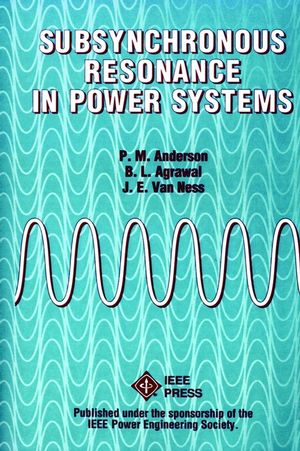Subsynchronous Resonance in Power SystemsISBN: 978-0-7803-5350-3
Paperback
288 pages
February 1999, Wiley-IEEE Press
 This is a Print-on-Demand title. It will be printed specifically to fill your order. Please allow an additional 10-15 days delivery time. The book is not returnable.
|
||||||
PART 1: INTRODUCTION.
Chapter 1: Introduction.
1.1 Definition of SSR.
1.2 Power System Modeling.
1.3 Introduction to SSR.
1.3.1 Types of SSR Interactions.
1.3.2 Analytical Tools.
1.4 Eigenvalue Analysis.
1.4.1 Advantages of Eigenvalue Computation.
1.4.2 Disadvantages of Eigenvalue Calculation.
1.5 Conclusions.
1.6 Purpose, Scope, and Assumptions.
1.7 Guidelines for Using This Book.
1.8 SSR References.
1.8.1 General References.
1.8.2 SSR References.
1.8.3 Eigenvalue/Eigenvector Analysis References.
1.9 References for Chapter 1.
PART 2: SYSTEM MODELING.
Chapter 2: The Generator Model.
2.1 The Synchronous Machine Structure.
2.2 The Machine Circuit Inductances.
2.2.1 Stator Self Inductances.
2.2.2 Stator Mutual Inductances.
2.2.3 Rotor Self Inductances.
2.2.4 Rotor Mutual Inductances.
2.2.5 Stator-to-Rotor Mutual Inductances.
2.3 Park's Transformation.
2.4 The Voltage Equations.
2.5 The Power and Torque Equations.
2.6 Normalization of the Equations.
2.7 Analysis of the Direct Axis Equations.
2.8 Analysis of the Quadrature Axis Equations.
2.9 Summary of Machine Equations.
2.10 Machine-Network Interface Equations.
2.11 Linear State-Space Machine Equations.
2.12 Excitation Systems.
2.13 Synchronous Machine Saturation.
2.13.1 Parameter Sensitivity to Saturation.
2.13.2 Saturation in SSR Studies.
2.14 References for Chapter 2.
Chapter 3: The Network Model.
3.1 An Introductory Example.
3.2 The Degenerate Network.
3.3 The Order of Complexity of the Network.
3.4 Finding the Network State Equations.
3.5 Transforming the State Equations.
3.6 Generator Frequency Transformation.
3.7 Modulation of the 60 Hz Network Response.
3.8 References for Chapter 3.
Chapter 4: The Turbine-Generator Shaft Model.
4.1 Definitions and Conventions.
4.2 The Shaft Torque Equations.
4.3 The Shaft Power Equations.
4.4 Normalization of the Shaft Equations.
4.5 The Incremental Shaft Equations.
4.6 The Turbine Model.
4.7 The Complete Turbine and Shaft Model.
4.8 References for Chapter 4.
PART 3: SYSTEM PARAMETERS.
Chapter 5: Synchronous Generator Model Parameters.
5.1 Conventional Stability Data.
5.1.1 Approximations Involved in Parameter Computation.
5.2 Measured Data from Field Tests.
5.2.1 Standstill Frequency Response (SSFR) Tests.
5.2.2 Generator Tests Performed Under Load.
5.2.2.1 The On-Line Frequency Response Test.
5.2.2.2 Load Rejection Test.
5.2.2.3 Off-Line Frequency Domain Analysis of Disturbances.
5.2.3 Other Test Methods.
5.2.3.1 The Short Circuit Test.
5.2.3.2 Trajectory Sensitivity Based Identification.
5.3 Parameter Fitting from Test Results.
5.4 Sample Test Results.
5.5 Frequency Dependent R and X Data.
5.6 Other Sources of Data.
5.7 Summary.
5.8 References for Chapter 5.
Chapter 6: Turbine-Generator Shaft Model Parameters.
6.1 The Shaft Spring-Mass Model.
6.1.1 Neglecting the Shaft Damping.
6.1.2 Approximate Damping Calculations.
6.1.2.1 Model Adjustment.
6.1.2.2 Model Adjustment for Damping.
6.1.2.3 Model Adjustment for Frequencies.
6.1.2.4 Iterative Solution of the Inertia Adjustment Equations.
6.2 The Modal Model.
6.3 Field Tests for Frequencies and Damping.
6.4 Damping Tests.
6.4.1 Transient Method.
6.4.2 Steady-State Method.
6.4.3 Speed Signal Processing.
6.4.4 Other Methods.
6.4.5 Other Factors.
6.5 References for Chapter 6.
PART 4: SYSTEM ANALYSIS.
Chapter 7: Eigen Analysis.
7.1 State-Space Form of System Equations.
7.2 Solution of the State Equations.
7.3 Finding Eigenvalues and Eigenvectors.
7.4 References for Chapter 7.
Chapter 8: SSR Eigenvalue Analysis.
8.1 The IEEE First Benchmark Model.
8.1.1 The FBM Network Model.
8.1.2 The FBM Synchronous Generator Model.
8.1.3 The FBM Shaft Model.
8.2 The IEEE Second Benchmark Model.
8.2.1 Second Benchmark Model—System #1.
8.2.2 Second Benchmark Model—System #2.
8.2.3 SBM Generator, Circuit, and Shaft Data.
8.2.4 Computed Results for the Second Benchmark Models.
8.3 The CORPALS Benchmark Model.
8.3.1 The CORPALS Network Model.
8.3.2 The CORPALS Machine Models.
8.3.3 The CORPALS Eigenvalues.
8.4 An Example of SSR Eigenvalue Analysis.
8.4.1 The Spring-Mass Model.
8.4.2 The System Eigenvalues.
8.4.3 Computation of Net Modal Damping.
8.5 References for Chapter 8.
Index.
About the Authors.



